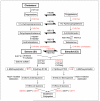Increased prevalence of EGFR-mutant lung cancer in women and in East Asian populations: analysis of estrogen-related polymorphisms
- PMID: 18593984
- PMCID: PMC3391698
- DOI: 10.1158/1078-0432.CCR-07-5030
Increased prevalence of EGFR-mutant lung cancer in women and in East Asian populations: analysis of estrogen-related polymorphisms
Abstract
Purpose: Somatic mutations in the epidermal growth factor receptor (EGFR) gene occur in a subset of non-small-cell lung cancer (NSCLC) and are highly predictive of the clinical response to selective EGFR kinase inhibitors. The prevalence of EGFR-mutant NSCLC is appreciably higher in females than in males and in East Asian than in Caucasian populations. We hypothesized that these disparate frequencies may be attributable to underlying genetic modifiers. Given the coincident differences in sex and ethnic origin, we tested allozymatic variants of enzymes involved in estrogen biosynthesis and metabolism, encoded by polymorphic alleles known to differ in frequency between Caucasian and Asian populations, as modifying alleles.
Experimental design: We genotyped nine polymorphisms in the CYP1A1, CYP17A1, CYP19, HSD17B1, COMT, GSTM1, and GSTT1 genes, in a series of 100 Japanese NSCLCs, selected for equal representation of EGFR wild-type (wt) and EGFR-mutant cases, as well as male and female cases. Associations between polymorphic variants and the EGFR genotype and sex of NSCLC cases were examined using Fisher's exact test of significance.
Results: Only CYP1A1 2C showed a difference in allele frequency that approached statistical significance. Heterozygotes were underrepresented among EGFR-mutant cases compared with EGFR-wt cases (27% versus 47%, P = 0.08), with a concurrent trend toward overrepresentation of CYP1A1 2C(Ile/Ile) homozygotes among EGFR-mutant cases as compared with EGFR-wt cases (69% versus 51%, P = 0.13).
Conclusion: Within the power of this study, our findings suggest that the selected polymorphic variants in the estrogen biosynthesis and metabolism pathways are unlikely to be major genetic modifiers of the prevalence of EGFR-mutant NSCLC.
Figures

Similar articles
-
Polymorphisms, mutations, and amplification of the EGFR gene in non-small cell lung cancers.PLoS Med. 2007 Apr;4(4):e125. doi: 10.1371/journal.pmed.0040125. PLoS Med. 2007. PMID: 17455987 Free PMC article.
-
Correlation between epidermal growth factor receptor mutations and expression of female hormone receptors in East-Asian lung adenocarcinomas.J Thorac Oncol. 2010 Jan;5(1):17-22. doi: 10.1097/JTO.0b013e3181c0a602. J Thorac Oncol. 2010. PMID: 19875972
-
East meets West: ethnic differences in epidemiology and clinical behaviors of lung cancer between East Asians and Caucasians.Chin J Cancer. 2011 May;30(5):287-92. doi: 10.5732/cjc.011.10106. Chin J Cancer. 2011. PMID: 21527061 Free PMC article. Review.
-
Epidermal growth factor receptor mutations in non- small cell lung cancers in a multiethnic malaysian patient population.Asian Pac J Cancer Prev. 2014;15(1):321-6. doi: 10.7314/apjcp.2014.15.1.321. Asian Pac J Cancer Prev. 2014. PMID: 24528049
-
Epidermal Growth Factor Receptor (EGFR) Pathway, Yes-Associated Protein (YAP) and the Regulation of Programmed Death-Ligand 1 (PD-L1) in Non-Small Cell Lung Cancer (NSCLC).Int J Mol Sci. 2019 Aug 5;20(15):3821. doi: 10.3390/ijms20153821. Int J Mol Sci. 2019. PMID: 31387256 Free PMC article. Review.
Cited by
-
A practical and adaptive approach to lung cancer screening: a review of international evidence and position on CT lung cancer screening in the Singaporean population by the College of Radiologists Singapore.Singapore Med J. 2019 Nov;60(11):554-559. doi: 10.11622/smedj.2019145. Singapore Med J. 2019. PMID: 31781779 Free PMC article. Review.
-
An integrated approach of network pharmacology, molecular docking, and experimental verification uncovers kaempferol as the effective modulator of HSD17B1 for treatment of endometrial cancer.J Transl Med. 2023 Mar 17;21(1):204. doi: 10.1186/s12967-023-04048-z. J Transl Med. 2023. PMID: 36932403 Free PMC article.
-
Afatinib overcoming resistance to icotinib and osimertinib in NSCLC with leptomeningeal metastasis in patients with acquired EGFR L858R/T790M or L858R/S768I mutations: Two case reports.Heliyon. 2023 Oct 8;9(10):e20690. doi: 10.1016/j.heliyon.2023.e20690. eCollection 2023 Oct. Heliyon. 2023. PMID: 37860534 Free PMC article.
-
Precision Immuno-Oncology in NSCLC through Gender Equity Lenses.Cancers (Basel). 2024 Apr 4;16(7):1413. doi: 10.3390/cancers16071413. Cancers (Basel). 2024. PMID: 38611091 Free PMC article. Review.
-
Molecularly targeted therapies for advanced or metastatic non-small-cell lung carcinoma.World J Clin Oncol. 2013 May 10;4(2):29-42. doi: 10.5306/wjco.v4.i2.29. World J Clin Oncol. 2013. PMID: 23696960 Free PMC article.
References
-
- Lynch TJ, Bell DW, Sordella R, et al. Activating mutations in the epidermal growth factor receptor underlying responsiveness of non-small-cell lung cancer to gefitinib. N Engl J Med. 2004;350:2129–39. - PubMed
-
- Paez JG, Janne PA, Lee JC, et al. EGFR mutations in lung cancer: correlation with clinical response to gefitinib therapy. Science. 2004;304:1497–500. - PubMed
-
- Sharma SV, Bell DW, Settleman J, Haber DA. Epidermal growth factor receptor mutations in lung cancer. Nat Rev Cancer. 2007;7:169–81. - PubMed
-
- Sordella R, Bell DW, Haber DA, Settleman J. Gefitinib-sensitizing EGFR mutations inlung cancer activate anti-apoptotic pathways. Science. 2004;305:1163–7. - PubMed
Publication types
MeSH terms
Substances
Grants and funding
LinkOut - more resources
Full Text Sources
Medical
Research Materials
Miscellaneous

